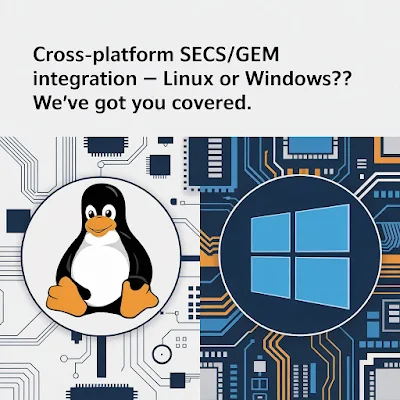In today’s era of advanced manufacturing and smart fabs, SECS GEM (SEMI Equipment Communications Standard / Generic Equipment Model) is a foundational protocol that ensures seamless communication between semiconductor equipment and host systems. As more manufacturers shift toward digitalization and automation, integrating SECS/GEM Software across platforms—especially Linux and Windows—is becoming increasingly vital.
Whether you're building new tools or retrofitting legacy systems, understanding how to execute SECS/GEM integration from concept to deployment is essential. This article explores how to implement SECS/GEM communication on both Linux and Windows, the benefits it delivers, and best practices to ensure compliance with the GEM300 standard.
The Need for Cross-Platform SECS/GEM Integration
Modern fabs consist of a wide variety of equipment, some running Windows-based control systems and others operating on Linux for better security and performance. Ensuring seamless SECS GEM communication protocol on both platforms is no longer a nice-to-have—it’s a must-have for uniform data flow, real-time control, and factory automation.
At the heart of this lies a SECS/GEM interface, which acts as a bridge between the equipment and the Manufacturing Execution System (MES).
By enabling a robust SECS/GEM protocol on Linux and Windows, manufacturers can:
- Enable real-time data exchange
- Standardize communication across different tool types
- Support GEM300 compliance for 300mm wafer fabs
- Automate recipe management, alarms, and status reporting
Whether you're integrating into a new tool or upgrading legacy equipment, a cross-platform approach is vital for future scalability.
SECS/GEM on Windows: Rapid Integration with SDKs
Windows-based SECS/GEM software solutions are well-established and widely adopted due to the availability of mature development tools and SDKs. Many vendors offer SECS/GEM integration toolkits with:
- Drag-and-drop UI components
- Built-in logging and message simulators
- Support for HSMS and SECS-I protocols
On Windows, integration generally involves deploying a
SECS/GEM interface module that handles SML (SEMI Message Language) transactions. Engineers can configure events, variables, and alarms directly through graphical interfaces, speeding up implementation.
Linux-Based SECS/GEM: Flexible, Secure & Scalable
Linux is becoming the platform of choice for OEMs seeking flexibility, low overhead, and better control over system resources. However, SECS GEM integration on Linux requires a more programmatic approach.
Modern SECS/GEM software SDKs for Linux offer APIs in languages like C++, Python, and Java. These SDKs support:
- Custom message handling for SECS/GEM communication
- Lightweight daemons for equipment interface
- Configuration via XML or YAML
- Full support for GEM300 standards
By integrating the SECS GEM protocol at the OS level, OEMs gain a highly secure and customizable interface without depending on GUI-heavy solutions.
Key Considerations for Cross-Platform SECS/GEM Integration
No matter the platform, here are some best practices to follow:
Choose the Right SDK: Ensure your SDK supports both Windows and Linux with consistent APIs. This reduces development effort and simplifies maintenance.
Compliance with GEM300: Ensure the software layer handles Process Module Management, Carrier Handling, and State Models as required by the GEM300 specification.
Customizable Messaging: Your SECS GEM communication protocol implementation should allow custom message definitions to suit unique fab requirements.
Data Security & Logging: Implement secure SECS/GEM communication channels, preferably using HSMS (High-Speed SECS Message Services), and maintain detailed transaction logs.
Testing & Simulation: Use simulators and compliance test tools to validate your SECS/GEM interface before deployment.
Conclusion: The Future is Cross-Platform and Connected
As fabs continue to evolve, the ability to implement
SECS/GEM Software on both Linux and Windows ensures flexibility, interoperability, and future-proofing. From enabling real-time data acquisition to achieving GEM300 compliance, effective SECS GEM integration is the backbone of smart manufacturing.
Whether you're an OEM developing new tools or a fab modernizing legacy systems, choosing the right SECS/GEM integration strategy will accelerate your journey from concept to execution.
🌐 Ready to enable cross-platform SECS/GEM integration?
Talk to our team today to explore flexible SDKs and turnkey solutions designed for both Linux and Windows platforms.

No comments:
Post a Comment